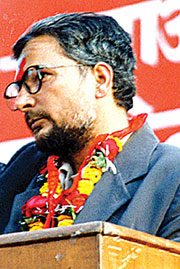 There is no direct relation between the end of the ceasefire and the 12-point understanding between us and the seven parties. When we entered into the agreement, we had very well envisaged that fighting would escalate once the king rejected the pact. That is why we made it a point to mention in the understanding paper that we (Maoists and parties) would separately launch offensives against the autocratic monarchy. Moreover, everyone understood that the role of the people's liberation army would be crucial if the king stood his ground to hold the municipal polls even within the army barracks. In this context, the end of the ceasefire would not negatively affect the 12-point understanding. It would rather be complementary to it. People agree that we need to have a mechanism that will monitor if the understanding has been followed. Toward that end and to make the agreement more effective, there has to be high-level talks between the two sides soon. What should be the nature of the movement depends on its goal. If the goal is to end the autocratic monarchy and establish a complete republic or democratic republic, there has to be coordination between the movements in rural and urban areas and also between armed and peaceful movements. It was due to the lack of coordination that the movements of 1955 and 1990 failed. That is why people need to be assured that our future military offensives will be complementary to the urban-centred peaceful movement. History has shown that there cannot be any Chinese wall between armed and peaceful movements. They are interchangeable. It is the leaders of the movements who can identify the timings for such transformations (from peaceful to armed movement and vice versa). We don't think it is wise to point fingers at one another remembering past enmity. If people talk about what they call atrocities by our cadres, then we too can recall how they (the parties) placed bounties on our heads and issued red corner notices against us, how they equipped civilians with the arms of the Royal Nepali Army to gun down our fighters. Till yesterday, because we Maoists and the parties had separate working policies and different goals, we clashed. But now we have a common target-the autocratic monarchy. Since our working policy is now the same, we have forged this partnership. But tomorrow if the nature of the political inter-contradiction changes, the nature of our relations could change as well.
There is no direct relation between the end of the ceasefire and the 12-point understanding between us and the seven parties. When we entered into the agreement, we had very well envisaged that fighting would escalate once the king rejected the pact. That is why we made it a point to mention in the understanding paper that we (Maoists and parties) would separately launch offensives against the autocratic monarchy. Moreover, everyone understood that the role of the people's liberation army would be crucial if the king stood his ground to hold the municipal polls even within the army barracks. In this context, the end of the ceasefire would not negatively affect the 12-point understanding. It would rather be complementary to it. People agree that we need to have a mechanism that will monitor if the understanding has been followed. Toward that end and to make the agreement more effective, there has to be high-level talks between the two sides soon. What should be the nature of the movement depends on its goal. If the goal is to end the autocratic monarchy and establish a complete republic or democratic republic, there has to be coordination between the movements in rural and urban areas and also between armed and peaceful movements. It was due to the lack of coordination that the movements of 1955 and 1990 failed. That is why people need to be assured that our future military offensives will be complementary to the urban-centred peaceful movement. History has shown that there cannot be any Chinese wall between armed and peaceful movements. They are interchangeable. It is the leaders of the movements who can identify the timings for such transformations (from peaceful to armed movement and vice versa). We don't think it is wise to point fingers at one another remembering past enmity. If people talk about what they call atrocities by our cadres, then we too can recall how they (the parties) placed bounties on our heads and issued red corner notices against us, how they equipped civilians with the arms of the Royal Nepali Army to gun down our fighters. Till yesterday, because we Maoists and the parties had separate working policies and different goals, we clashed. But now we have a common target-the autocratic monarchy. Since our working policy is now the same, we have forged this partnership. But tomorrow if the nature of the political inter-contradiction changes, the nature of our relations could change as well.
PIC: MIN BAJRACHARYA


